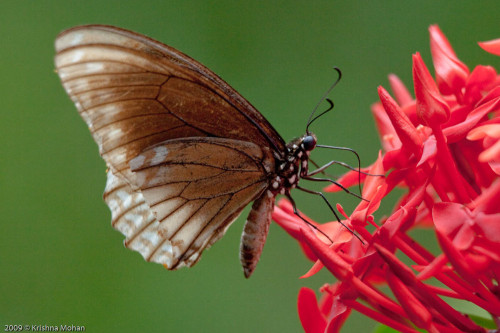
The Common Mime (Chilasa clytia) is a Swallowtail butterfly found in South and South-east Asia. The butterfly belongs to the Chilasa group or the Black-bodied Swallowtails. It serves an excellent example of a Batesian mimic among the Indian butterflies. Wingspan of 90-105 mm. This is butterfly has dimorphism for both sexes – there are two different colour forms for each sex. The lighter form dissimilis mimics the unpalatable Blue Tiger (Tirumala limniace) while the darker form clytia mimics the unpalatable “Crows”. This is clytia form which looks like Common Indian Crow (Euploea core).
The upper sides and under sides of clytia are a rich dark brown – the colour towards the margins of the wings is much paler. There is a series of creamy to white markings towards the outer margins, many of which are chevron shaped. The spots on the margins between the veins are creamy and small. Towards the outer margins of the hind wings, there are two rows of cream coloured chevrons, the outer being much smaller than the inner. The margins of the hind wings have orange yellow spots between the veins; the ones on the lower side are much larger. This specimen had the wings damaged so the the markings are not very clear.
The ground colour of the wings of dissimilis is blue-gray, with heavy black markings along the veins, giving it a somewhat reticulate appearance. The chevron shaped markings towards the outer margins are similar to those of form clytia.
This butterfly is found in India from Kangra to Sikkim, from Assam to Burma, Nepal, Bangladesh, Peninsular India and the Andaman Islands. It is also found in Sri Lanka, Thailand, Southern China (including Hainan), Hong Kong, Vietnam, Laos, Kampuchea, peninsular Malaysia, Philippines and Indonesia (Flores, Alor, Timor and Moa). Several regional variants and forms are recognized.
It usually flies within a few feet of the ground when searching for nectar or larval host plants. However, it is not uncommon to see it nectaring on blooms high up in the canopy. It prefers wooded areas with open spaces. It is not uncommon in home gardens.
It resembles its unpalatable Danaid models exceptionally well, not only in its markings and general coloration, but also in its behavior. For instance, when flying, it glides for a considerable distance after taking a few leisurely wing beats. After settling on a flower, it keeps its wings quite still like the models and does not continuously vibrate its wings like a typical swallowtail. Like its models, it sleeps with its wings folded over its body, often hanging onto a twig.
It is interesting to note that form clytia in Sri Lanka differs from its subspecies in India in almost the same way that the Indian Common Crow in Sri Lanka differs from its subspecies in India, illustrating the evolutionary selection pressure exerted on the mimics to look more and more like the model in their own environment.
The larvae feed on species of Litsea, Cinnamomum and Nauclea. The pupa of this butterfly is remarkably well camouflaged and resembles a broken twig so well that if a bird were to memorize its image, it will probably pick many dead twigs before it gets it right!

